2023
EVENT TRENDS REPORT
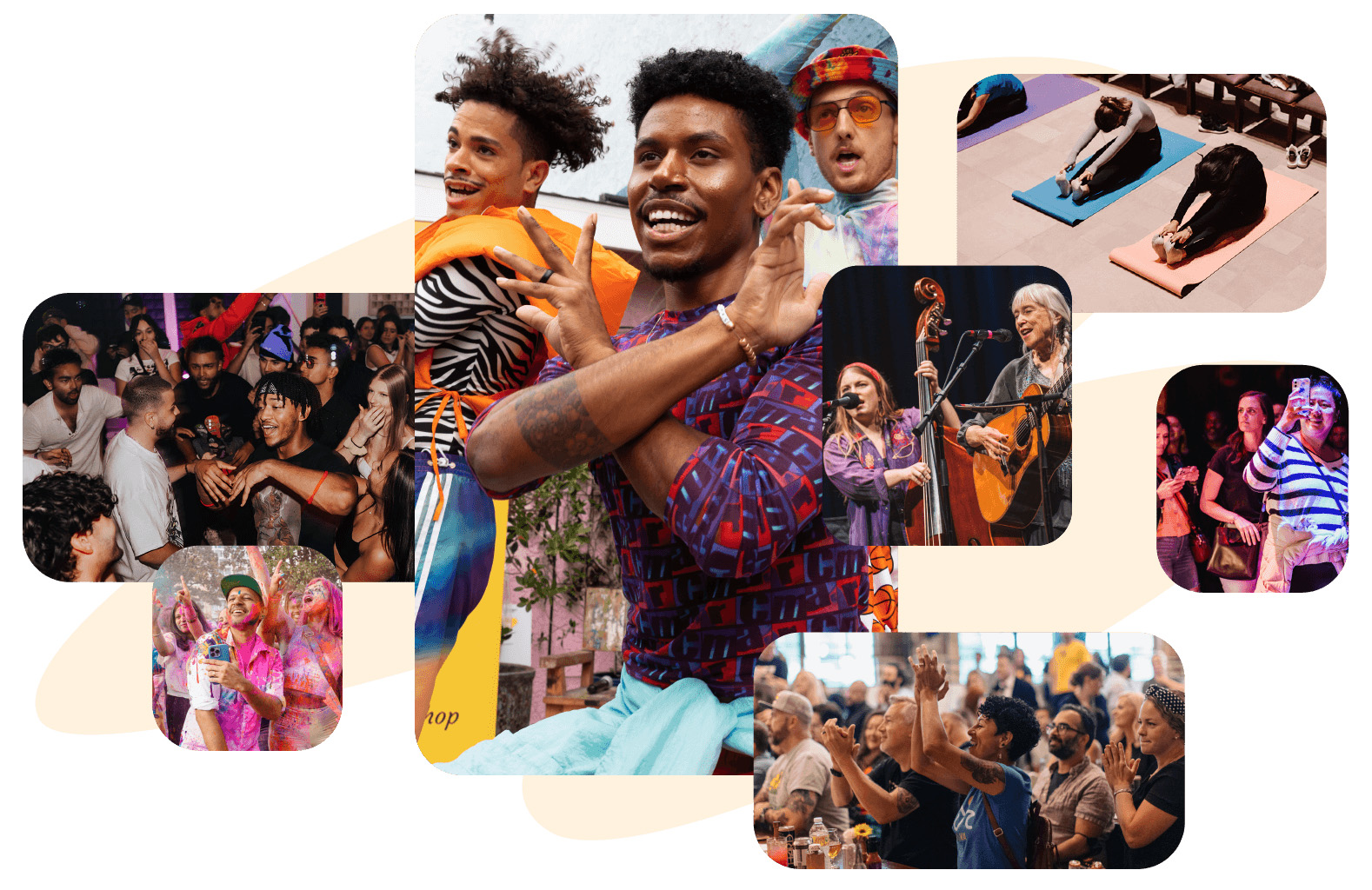

Back to reality and a new set of challenges
To say it’s been an unprecedented couple of years for events is an understatement. And, as we gear up for 2023, we wanted to know how our community of creators are preparing and planning for the year ahead.
At the end of 2022, we surveyed event creators across the UK, Ireland, Australia, New Zealand, the USA and Canada. All told, 1,581 respondents answered our questions, revealing their hopes (and fears) for the future of their industry and the message was clear: events are back and momentum is building!
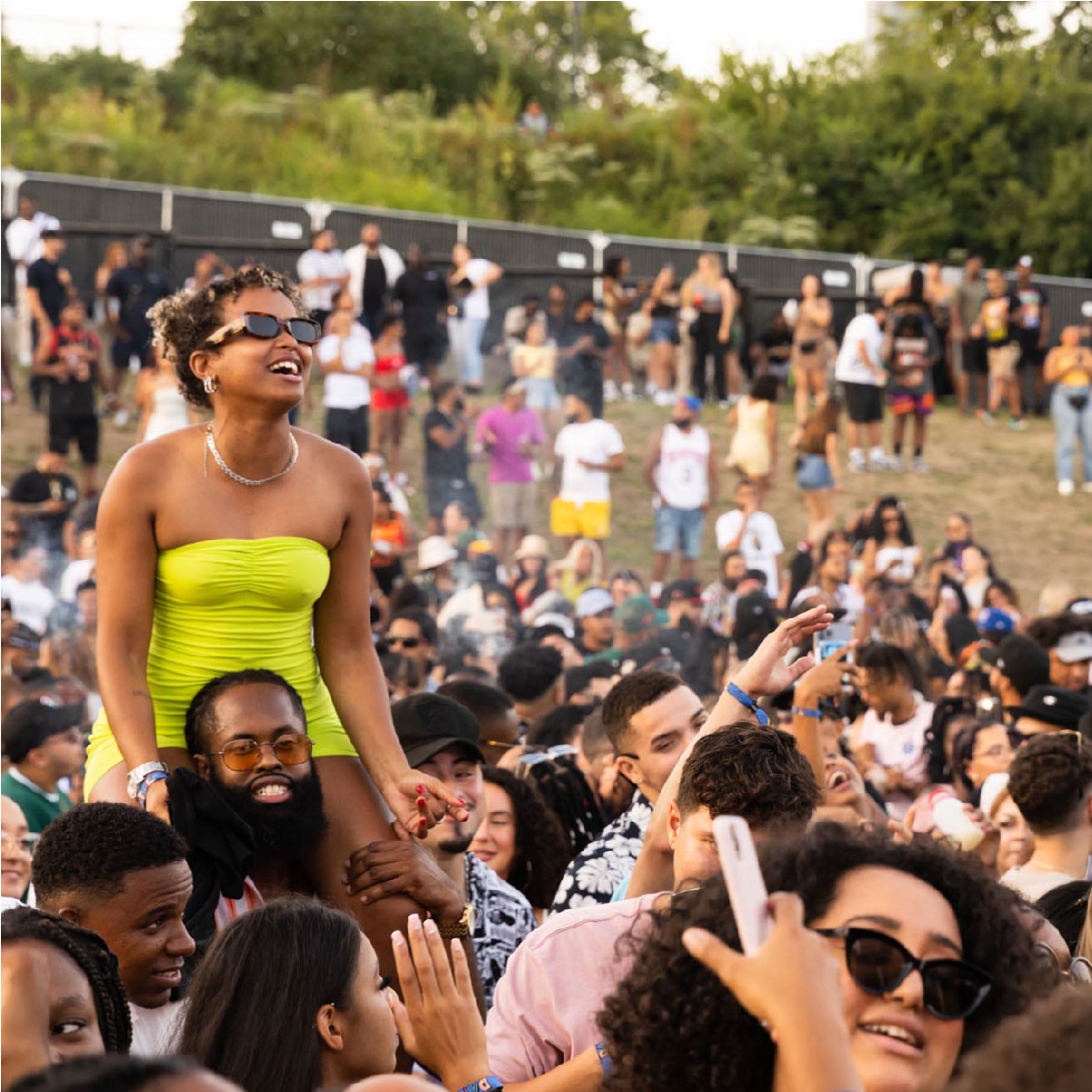
As the restrictions and regulations of the pandemic fade into the past, there’s plenty to be optimistic about and many creators reported looking forward to welcoming increasing numbers of attendees and organising more frequent events.
That said, it’s impossible to ignore the impact that economic turmoil and the current cost of living crisis are likely to have. However, despite the challenges they face, event creators across the board inspired us with their resilience.
Creators should feel confident in the fact that, if the pandemic has taught us anything, it’s that real-life interactions and experiences are highly valued. As a result, the eight trends we’ve identified for 2023 are all about delivering on attendees’ expectations.
On that note, for the first time in the history of our annual Event Trends Report, we reached out to event attendees – asking 4,474 respondents how events make them feel and what they want to do with their post-pandemic freedom! Overwhelmingly, their responses called for more opportunities to connect with fellow fans, with many saying they’ll spend more money than they did in 2022 to secure these special moments.
Read on to hear what attendees and creators in the UK and Ireland are saying and start shaping your 2023 strategy today.

With the rolling back of restrictions, everyone had high hopes for 2022. And while attendees around the world expressed an appetite for live events, the scene remained uncertain with closed venues, cancelled shows and spikes in cases shaking attendee confidence. However, as we look forward to 2023, it’s a different story.
Across every region we surveyed, most respondents said they plan to attend more events in 2023 compared to 2022. Younger people are especially determined to make 2023 a standout year. Globally, 61% of Gen Y and 63% of Gen Z say they’ll be at more events in 2023, compared with 52% of Gen X.
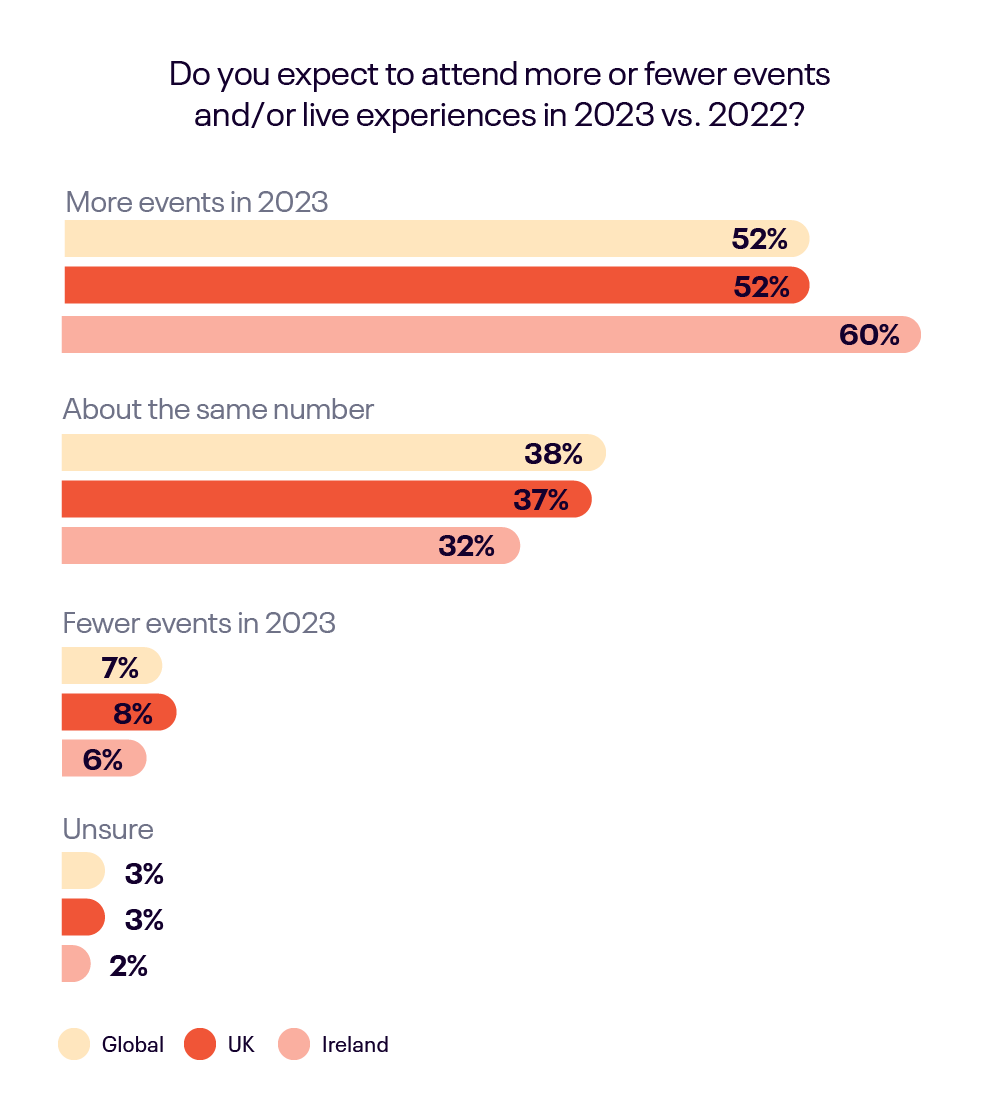
But with the economy in turmoil, will this intention translate into ticket sales? More than 80% of respondents in the UK and Ireland (81% in the UK and 83% in Ireland) believe inflation will increase in 2023, causing them to tighten their budgets. However, despite global inflation and financial pressures, we believe spending for events is fairly resilient.
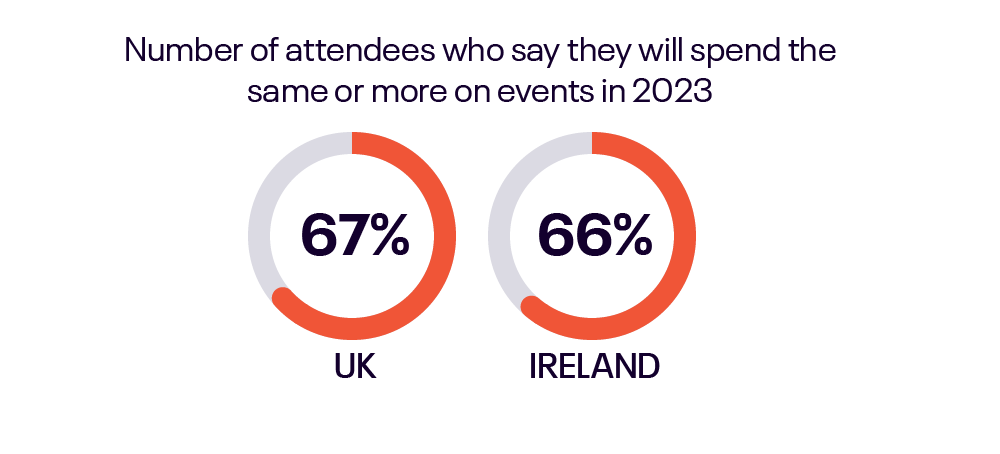
So what makes us think events are more resilient than other areas of the economy? Firstly, the increasing consumer preference for spending on experiences over objects, which we’ll explore next. And, secondly, the emergence of an important audience segment: the ‘essentialist’.
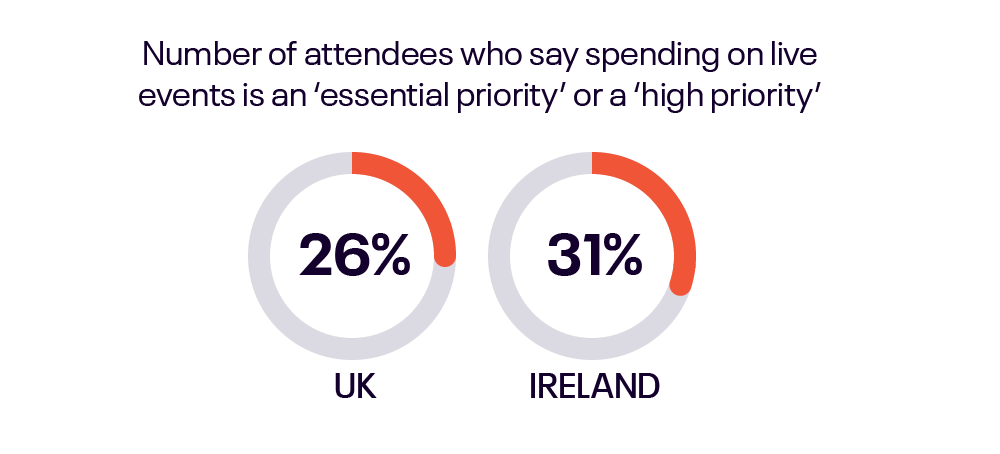
Our consumer survey revealed that, globally, essentialists are more likely to say they’ll spend more on events in 2023 (45% compared to the 30% global average) and we’ll look at how you can attract these high-value fans in more detail later.
“Given the overwhelmingly positive response to events in 2022, I’m optimistic that 2023 will be a good year. Concerns about affordability in a cost of living crisis are mitigated by a need for people to forget their woes and have fun with friends and family.”
— Hannah Saunders, Big Fish Little Fish
We knew this already, but it’s nice to see it confirmed. Event creators are not just entertaining, educating and fundraising – they are the architects of happiness and are responsible for generating positive emotions. The people we surveyed said in-person events are places where they feel ‘happy’ and ‘energised’, while open-ended responses made it clear that post-pandemic events are all about connection. As a result, event creators would be wise to double down on experiences promoting togetherness and fostering community.
One quick aside. Globally, Gen Y (21%) and Gen Z (25%) are more likely to agree with the statement ‘in-person events make me feel anxious’ and this is an important consideration for creators. How can you help lessen anxiety through pre-event communication and on-site experiences? We’ll touch on this more in trend 6.

This feel-good factor is one of the things that elevates an event into an experience. In fact, many attendees said their most memorable moments in 2022 were not so much about the event itself but the people they went with or met there and the atmosphere. In other words, it’s the overall experience that encourages people to spend on events, even when budgets are tight.
“I design an experience, as opposed to an event – from the sensory elements and unusual visuals to the location. Attendees come away having created something unique that they haven’t done before. Then they return with friends or family for them to experience it.”
— Jylle Navarro, Neon Naked Life Drawing
Today, the ability to design and deliver experiences is an essential skill for event creators. Especially as most respondents would rather receive a ticket to a live experience than a physical gift.
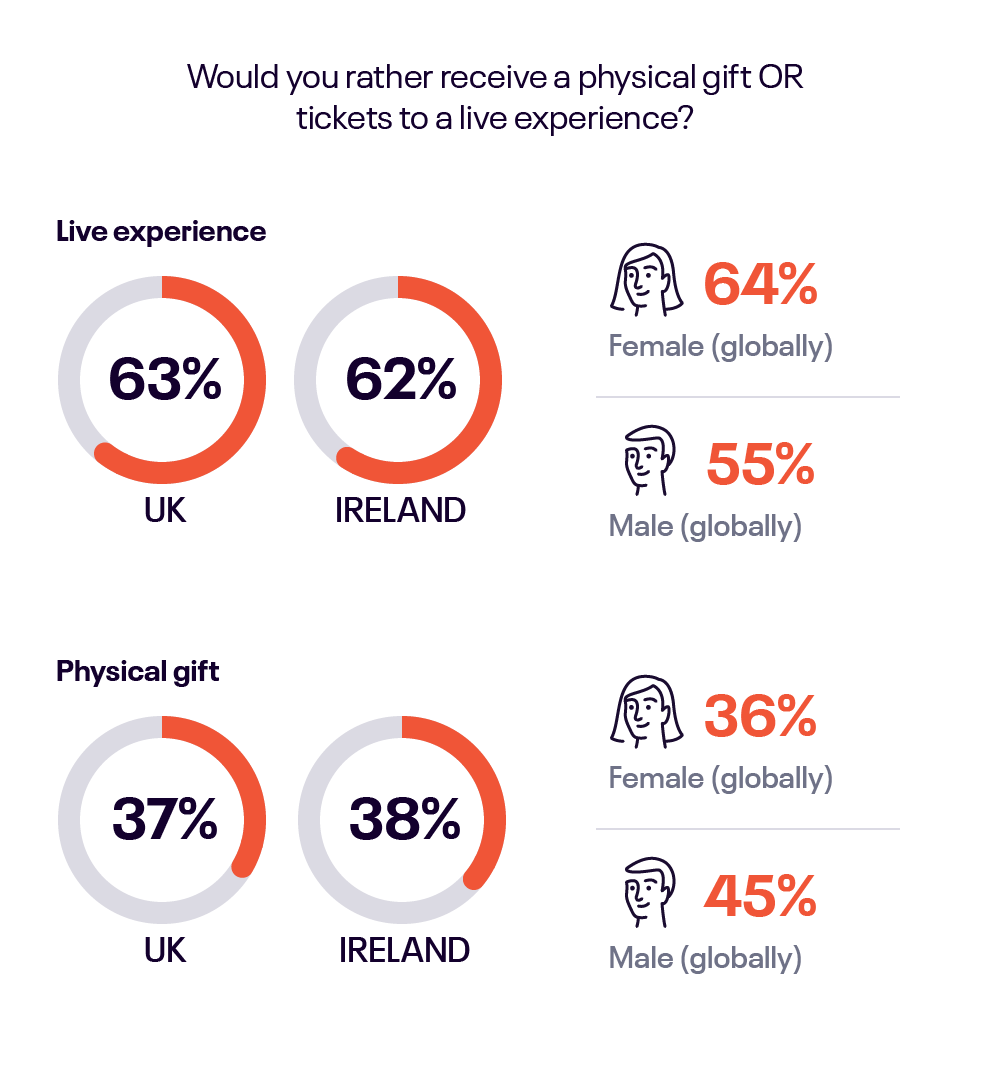
The experience economy
Today, two in three event creators around the world agree that their job is less about producing events and more about designing experiences, and this mindset change has serious implications.
Producing a memorable event requires more than a tactical game plan. Within the experience economy, creators are focusing on building communities and authentic in-person connections around surprising, delightful and must-return experiences – many of which include a tech-forward element. And just as importantly, these special moments and feel-good sensations should outlast the event – see trend 7 to discover how you can give attendees what they want by being always-on.
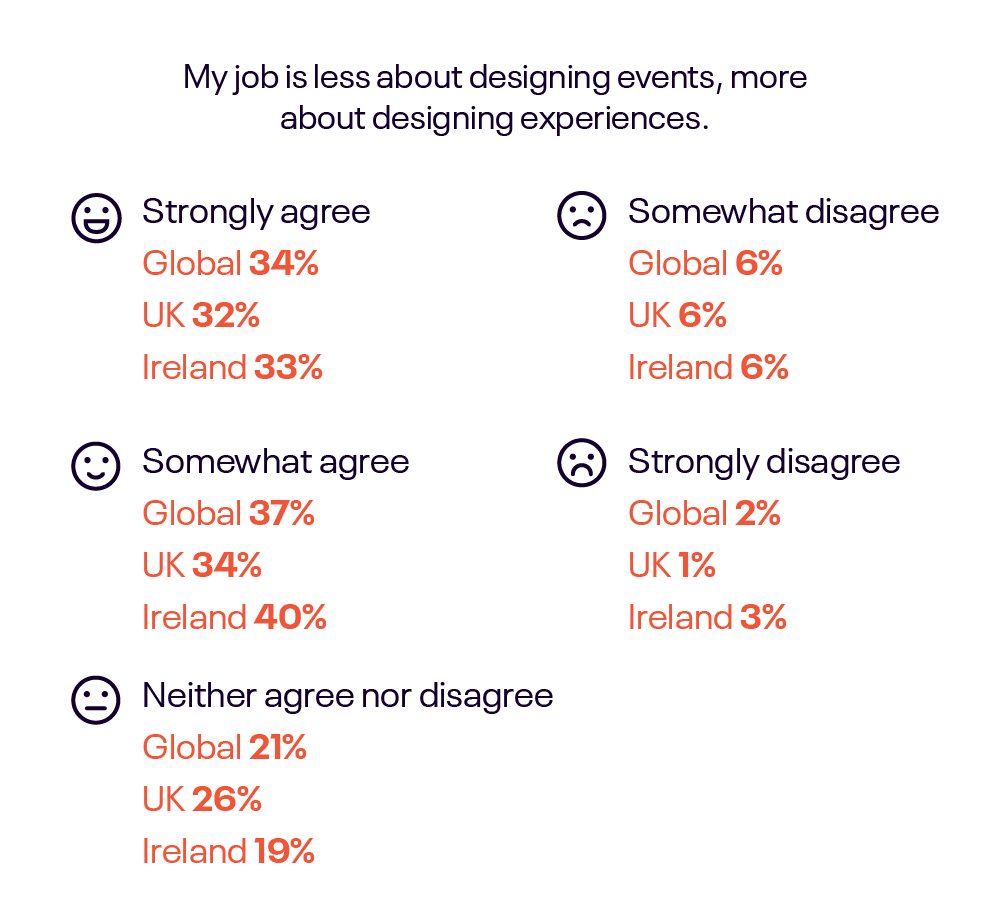
Attendees are enjoying the post-pandemic party atmosphere but, when pressed on their preferences, many gravitated towards what they already know – like attending local venues with familiar friendship groups. In addition, the questions revealed a preference for pandemic-friendly settings – such as outdoor locations as well as venues that are close to home and don’t require much travel.
Without comparative data from 2019, we don’t know if this signals a post-pandemic cultural shift, but one thing’s for sure – event creators should lean into this desire for known experiences and local communities.
What was the best event and/or live experience you attended in the last year?
“Going to see a local band at a local gig … it was special as they played a lot of music I liked. It brought back so many good memories.”
— Ireland, Eventbrite Consumer Survey, 2022
“2022 has been a trial for us as we restarted the events business targeting a new post-pandemic audience. This has been a huge learning curve since our weekday events now have to attract people who are no longer in the office from Monday to Friday.”
— Logan Gunasingham, REZtron
Taking things further, it’s worth digging into the global generational divide to gain a more accurate sense of what attendees want. For example, while the majority of Boomers look for a location they know (68%), most Gen Z respondents are willing to explore a new spot (60%).
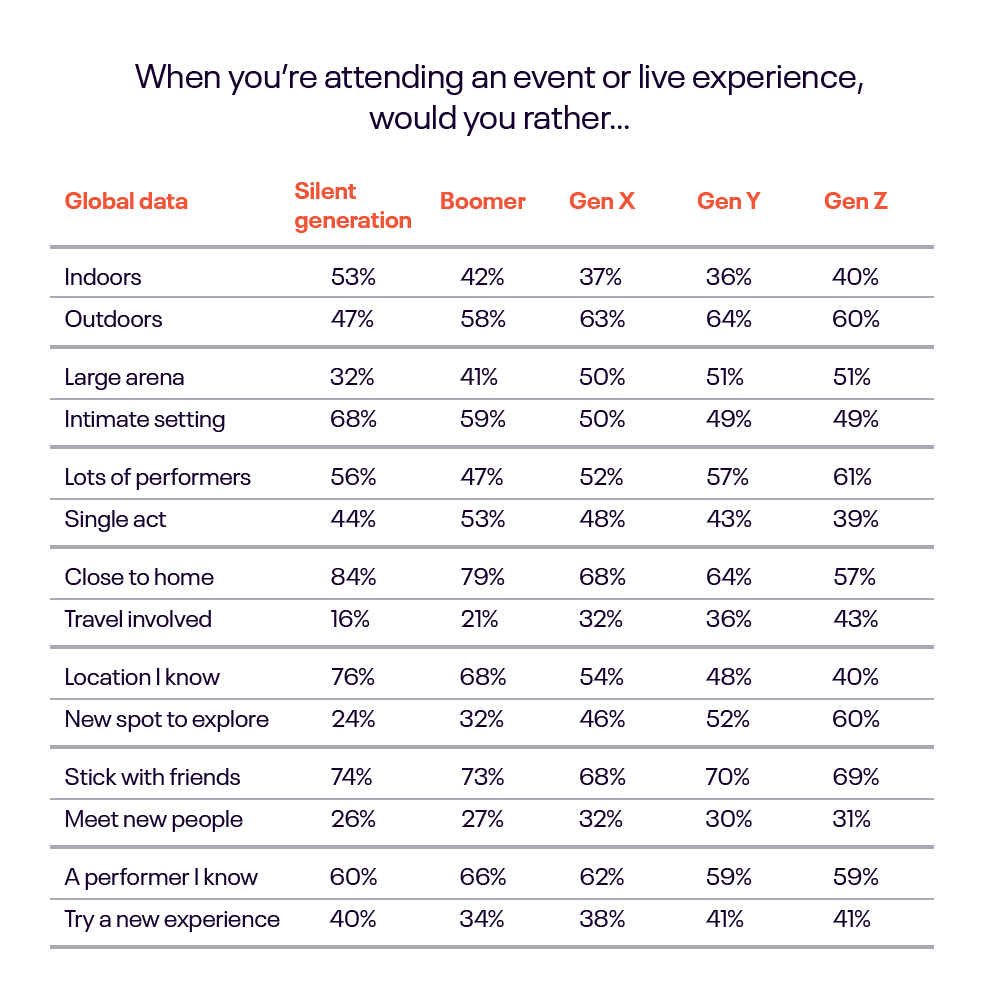
We also asked attendees what they want to see more of in 2023, with music festivals and live performances scoring highly – followed by a keen interest in fitness and fundraising.

Audience research remains key for event creators keen to provide personalised experiences – from VIP tickets and upscale amenities to ultra-niche attractions for specific segments. So in 2023, invest time and effort in pre-event and post-event surveys, market research, competitor research and even on-site short interviews to get to know your audience better.
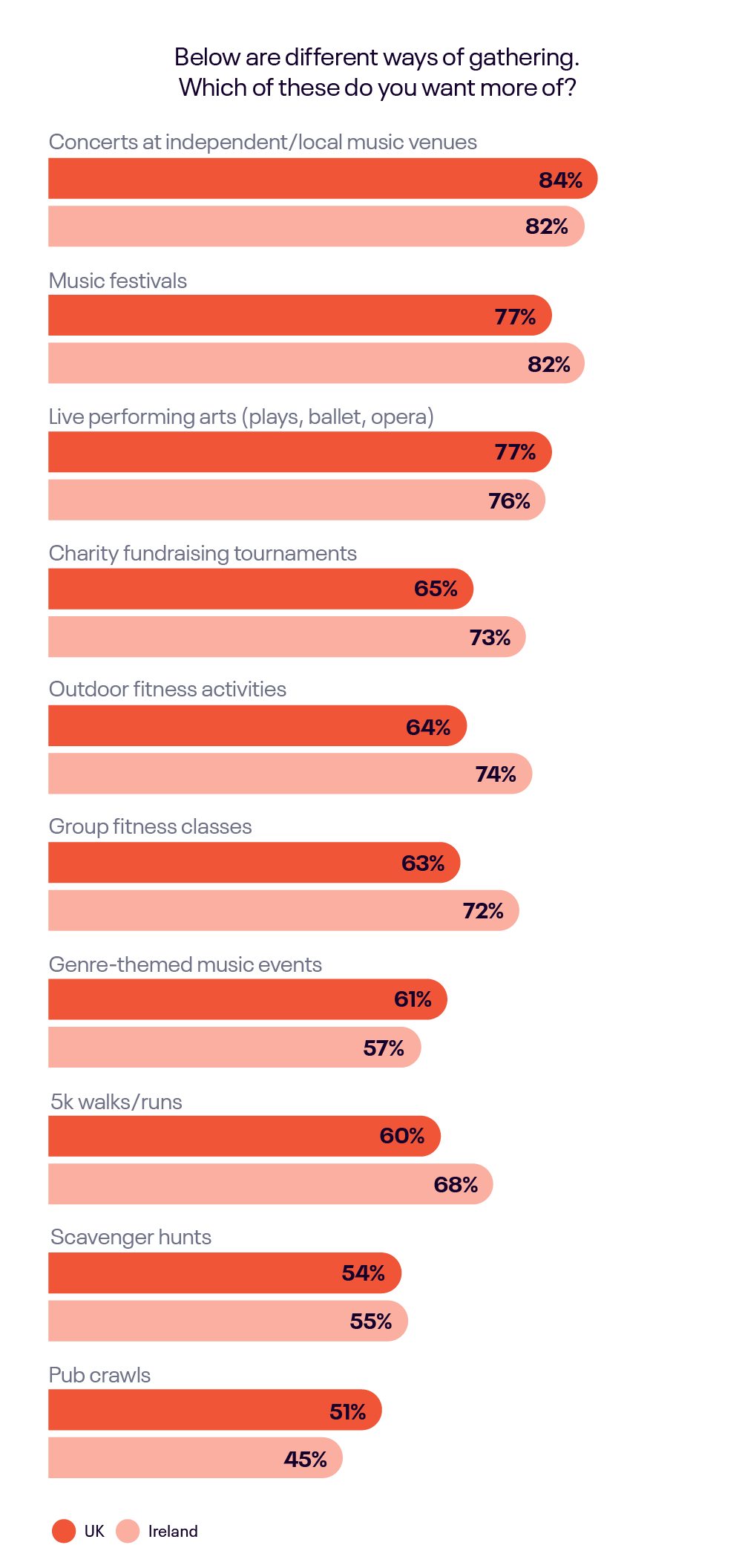
Virtual events are another pandemic habit that appears to be here to stay. Respondents cite several advantages – from ease and affordability of attendance (particularly with regard to associated costs like travel, for example) to the casual approach to attire – with 11% of people globally saying they like virtual events because it means they don’t have to shower!
That’s right, despite face-to-face meet-ups being back on the agenda, the number and size of online events may not shrink as drastically as you might expect. Our survey found virtual venues from Zoom to Google Meet remain an attractive option for attendees and a critical way for creators to grow their overall attendee base.
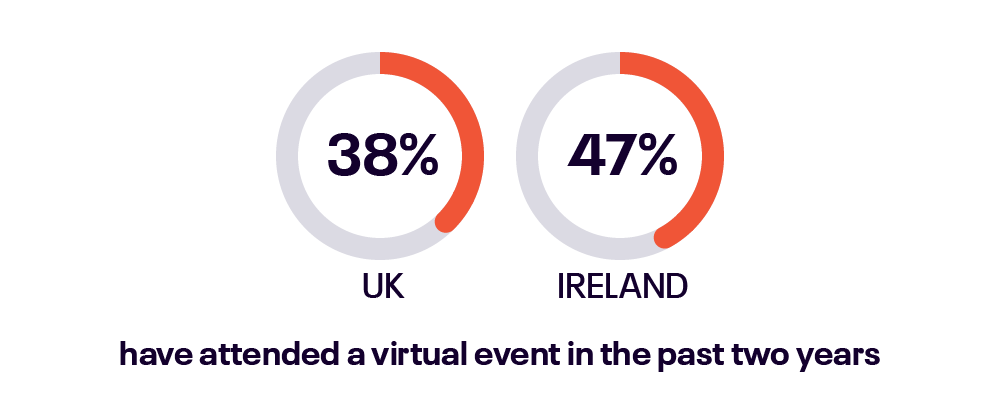
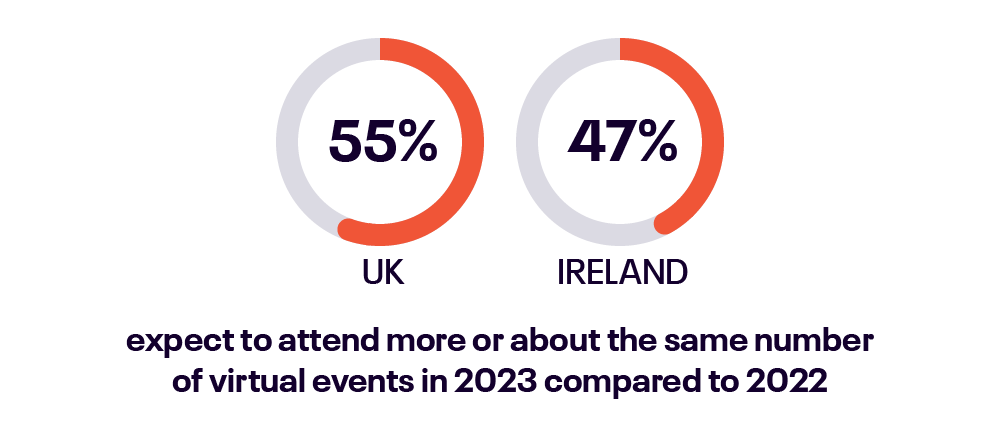
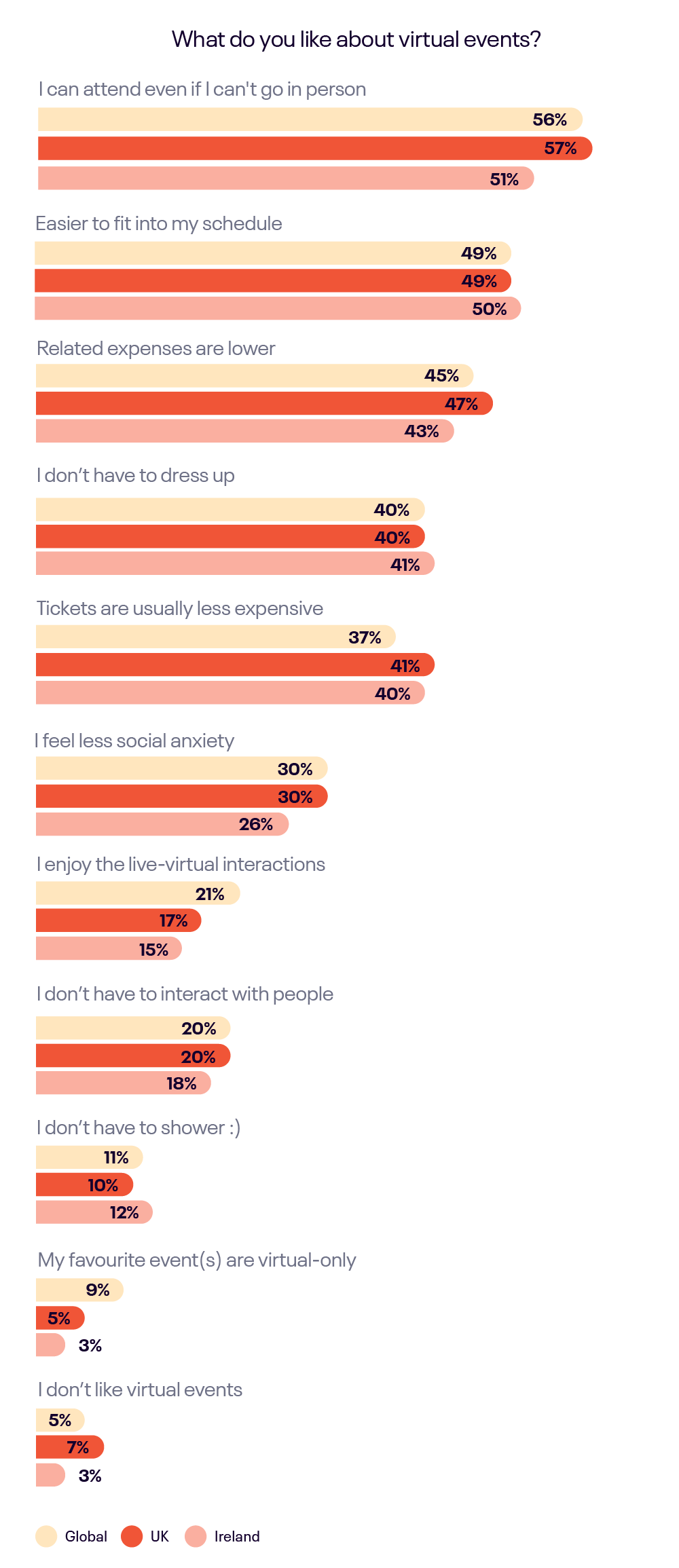
If you want to diversify revenue sources in 2023, or make your existing online events more resilient, it’s time to see digital as a complementary channel as opposed to a second-best option when in-person events aren’t possible.
The majority of respondents (55% in both the UK and Ireland) set their virtual ticket prices lower than their in-person ticket prices. However, many event creators in the UK (39%) and Ireland (40%) say they price virtual tickets at the same level as in-person. This shows that creators who don’t host virtual events (or simply host them as an emergency option) are missing out on a potential revenue opportunity.

Just as attendees are keen to go to more events in 2023, creators expect to see a growth in attendance (50% in the UK and 42% in Ireland) as well as a growth in ticket prices (42% in the UK and 43% in Ireland). As a result, many are exhibiting high levels of optimism.
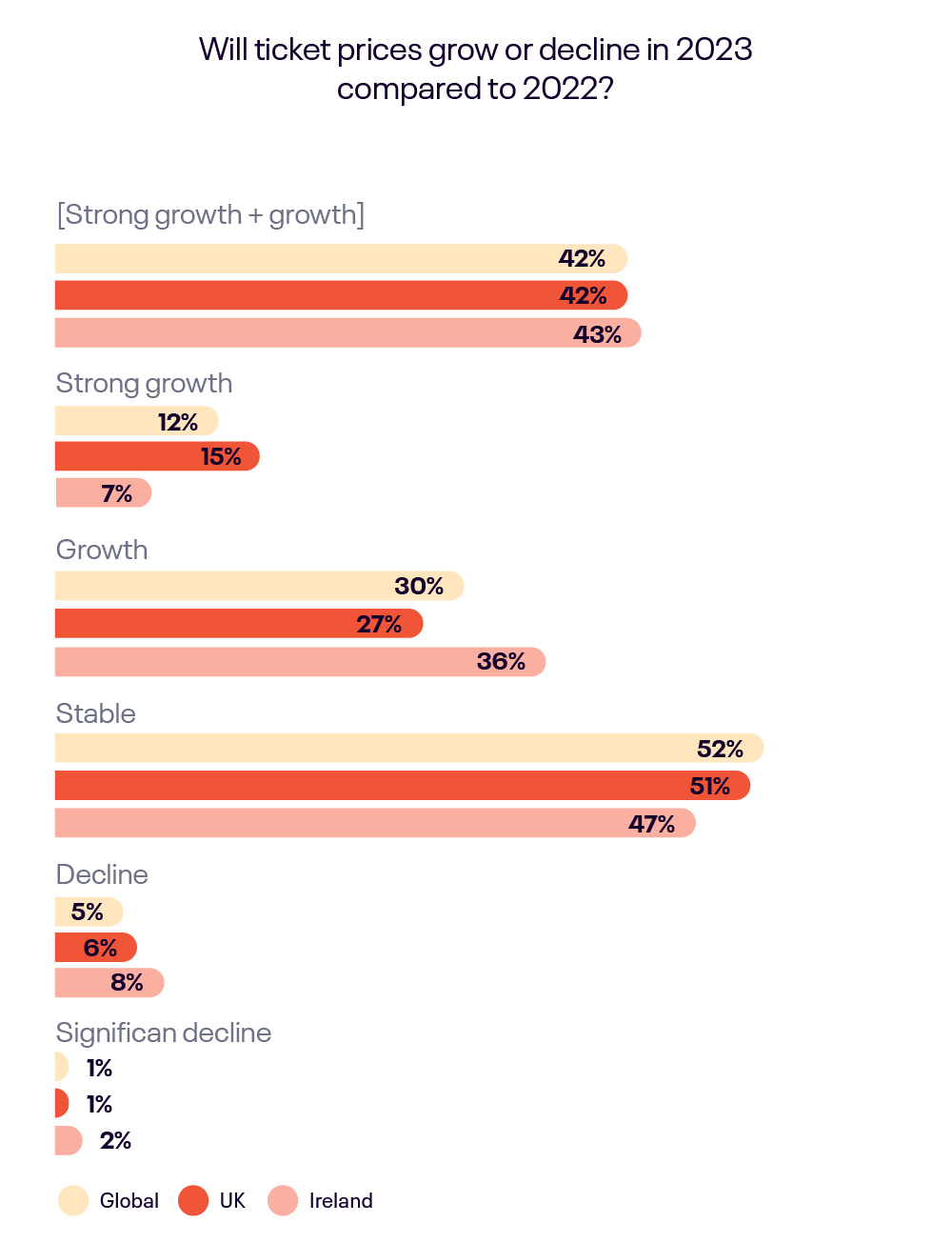
However, worsening economic conditions mean many are realistic as to the challenges that lie ahead and, with this in mind, ‘guarded optimism’ may be a better phrase. In the UK, the majority (55%) say conditions are getting worse – the highest level in any country we surveyed – while in Ireland, 46% of respondents acknowledge they must brace for challenging conditions over the next 12 months.
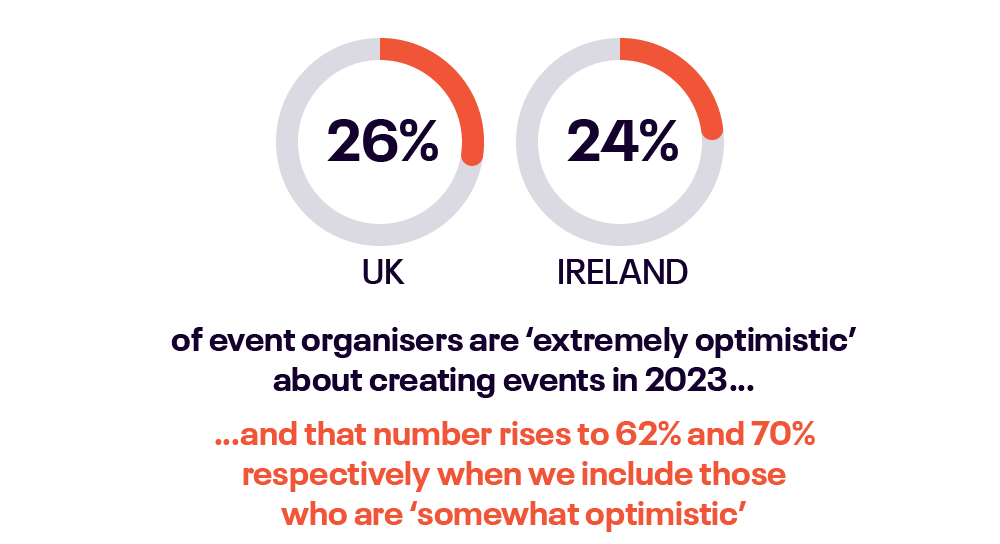
“Our budget will definitely increase, as we need to compete with a new wave of events coming out since the pandemic. So we have to stand out while still offering the uniqueness of what we do with our ‘retrotainment’. Ticket prices will also have to increase to cover the increased cost of venue hires and catering for some of our events.”
— Logan Gunasingham, REZtron
Demand for in-person events and ‘back to normal’ experiences might be high, but rising overheads and uncertain consumer demand in the face of inflation might well result in a gap between attendance growth and budget growth.
When asked the question, “Will attendance at events grow or decline in 2023 compared to 2022?”, 50% in the UK and 42% in Ireland say audience attendance will grow. However, when asked, “Will your budget per event grow or decline in 2023 compared to 2022?”, only 38% in the UK and 35% in Ireland say their budgets per event will grow. This equates to a -12% gap in the UK and a -7% gap in Ireland between attendance growth and budget growth.
“As the cost of materials increases, we will no doubt have to factor this into our budgeting for workshops. We do, however, also need to balance this with the economic situation faced by many of our customers at the moment, so will aim wherever possible to keep any increases to an absolute minimum.”
— Catherine Dolan, Handmade Creative Workshops
In addition, events that depend heavily on corporate and brand sponsorship are likely to face pressure as companies cut advertising and promotional budgets. In fact, 16% of creators in the UK and 28% in Ireland cited securing sponsorship as one of the biggest challenges they’ll face in 2023.
Not surprisingly, ‘insufficient budget’ was the most commonly cited challenge for 2023 (28% in the UK and 39% in Ireland – the highest percentage in all the regions where we conducted our survey). Once again, 2023 will see event creators trying to increase event income and do more with less. This extends to marketing with ‘free’ channels, such as word-of-mouth and organic social, to help creators connect with attendees.
Responding to 2023’s top challenges
While creators can’t fix the economy, they can make sure their 2023 budgets reflect the reality of rising prices and think realistically about what can be achieved with the resources they have available to them.
With 32% of UK event creators (and 18% in Ireland) saying the biggest challenge they face is ‘reaching attendees’, we take a look at how organic social channels can maintain connections at no cost in trend 7. In trend 8, event organisers are also encouraged to come up with creative responses to ‘increased competition’ – a challenge cited by 24% of UK event creators (and 22% in Ireland).
Introducing a new event consideration for 2023: creating experiences for introverts.
We asked attendees to define themselves as ‘extroverts’ (people who tend to feel energised by social time with others), ‘introverts’ (people who tend to prefer spending time alone or in small groups) or a mixture of the two.
The result? 29% of UK and 25% of Ireland respondents called themselves introverts – and this group behaves significantly differently than extroverts and those who call themselves a mix of both.
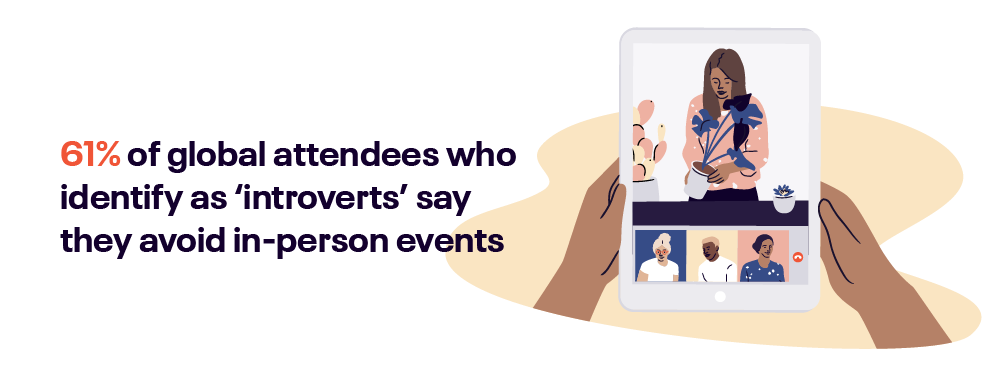
Of the 30% of global attendees who identify as introverted, 61% say they avoid in-person events because it involves socialising and/or meeting new people.
So what else does our research reveal about this audience segment?
Remember, event creators who don’t tailor event communications and on-site considerations risk alienating introverted attendees.
Next up, essentialists – those who say live events are an essential or high priority. These high-value fans are willing to spend more money on events than the average attendee and, perhaps most surprisingly, are also more likely to be introverts (32%) than extroverts (26%).
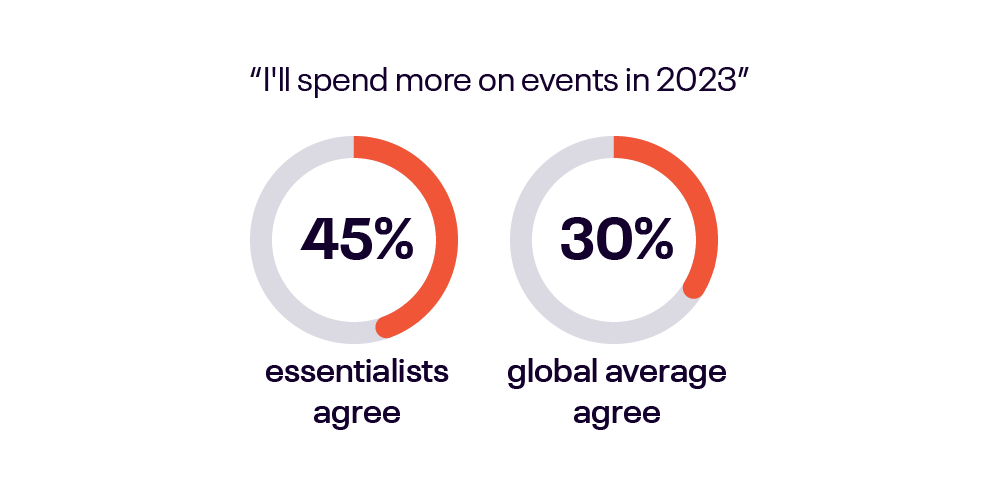
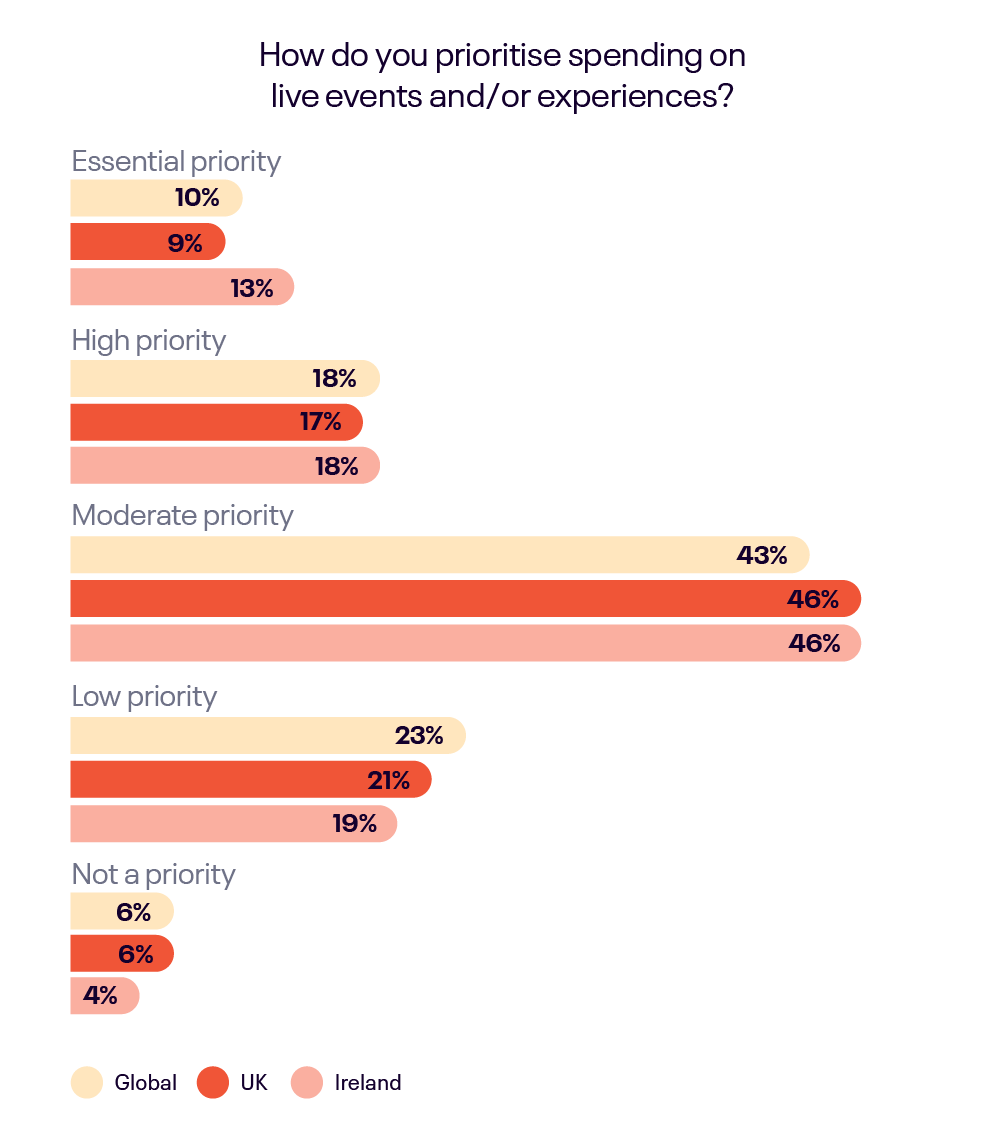
We’ve looked at how important music is to essentialists (see trend 2) but concerts and live performances aren’t the only things they connect with. Essentialists are much more likely to embrace 5k walks or runs, silent discos and spiritual, networking or speed-dating events than the average attendee. Again, for event creators serving these niches, it’s worth paying special attention to this high-value crowd.
So what’s one essential addition to your 2023 to-do list? Find out who your ‘essentialists’ are and build special outreach programmes to attract them.
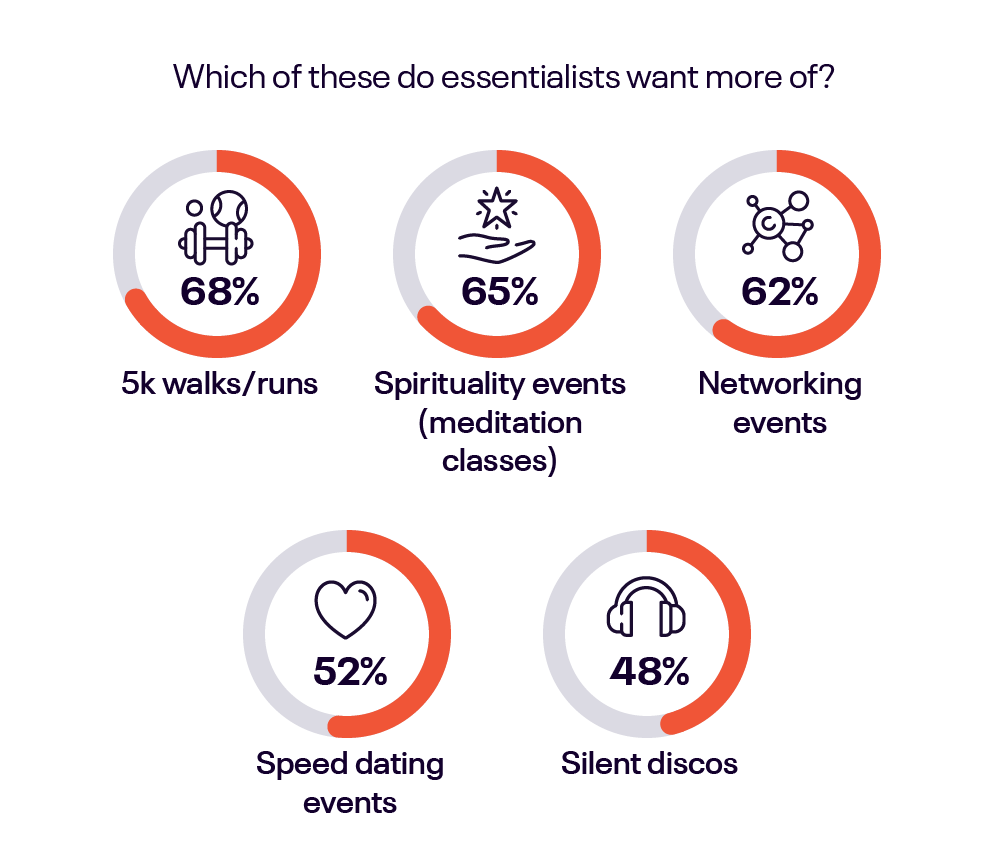
Our survey revealed the saddening statistic that one in four people (24% in the UK and 29% in Ireland – the second-highest region after the US) say they are almost always or often ‘socially isolated and/or lonely’. For many, this sense of isolation was exacerbated by the pandemic, which means the return of in-person events has been especially welcomed by the 60% of respondents in the UK and 56% in Ireland who said events reduce their feelings of isolation and/or loneliness.
Our consumer survey also revealed that events make people feel happy, connected and energised, and we’ve already touched on the power of events to promote positive emotions in trend 2.
What was the best event and/or live experience you attended in the last year?
“Being within a crowd full of people who share a love of a particular artist, everyone singing and dancing and laughing. It was very heartwarming, and I felt at home.”
— UK, Eventbrite Consumer Survey, 2022
However, attendees want creators to keep the upbeat atmosphere going and continue to promote connections between events. Achieving this lies in your ability to build a community – both in real life and online – which is something that many creators see as critical to expanding their attendee base.
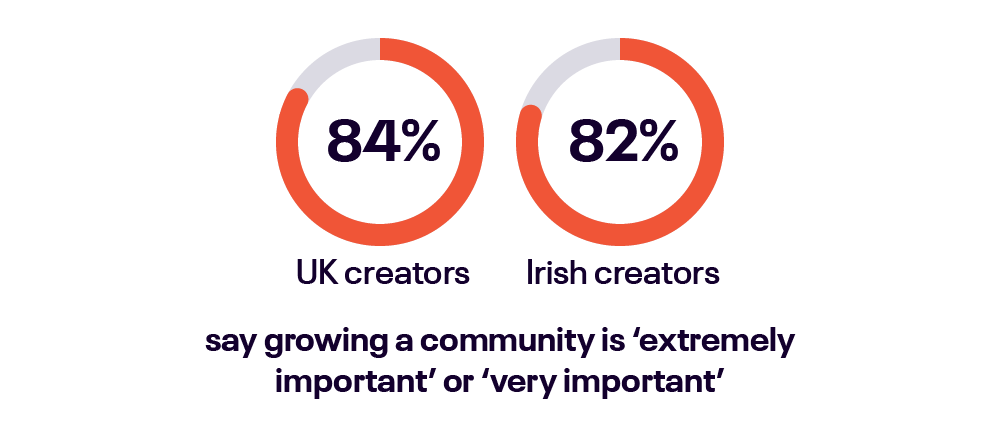
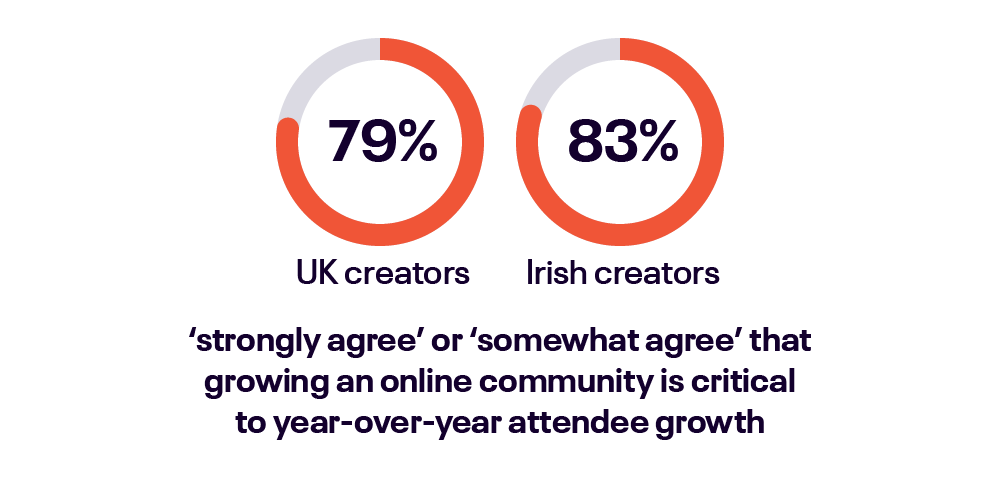
The challenge is that growing a community means event creators must compete against not just other event creators, but also content creators, media companies and brand marketers – all of who are seeking to attract and retain consumer attention via their online presence and social channels. So it’s no wonder ‘growing subscribers’ is the top challenge for creators when it comes to building a community – 36% in the UK and 37% in Ireland.
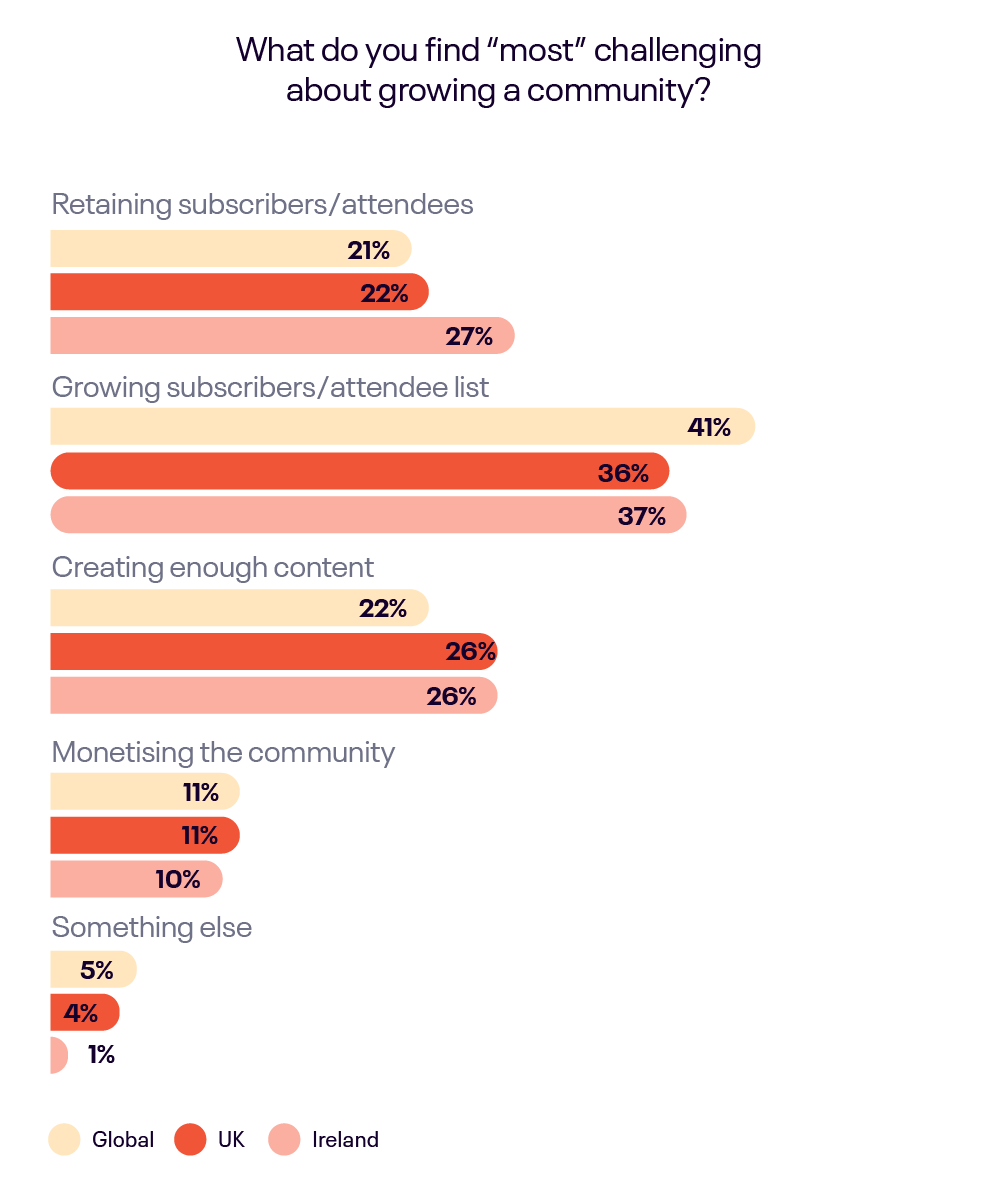
Creators already rely heavily on organic, owned marketing channels and email marketing to reach new attendees, and in 2023, they’ll have to be even savvier about how they win attention.
The top most effective tactics creators use to promote their events are organic (unpaid) social media (43% UK and 36% Ireland), email marketing (40% UK and 30% Ireland) and social ads (19% UK and 29% Ireland). However, these two regions are among the lowest when it comes to content marketing – only 16% of creators in the UK cite this as an effective tactic compared to the global average of 21% – meaning it might be time to turn your attention to writing blog posts designed to educate and inspire attendees. In other words, to convert their interest into ticket sales.
Social media isn’t only about promoting events; it has also become an event destination in and of itself. Creators can use Facebook Live, Instagram Live or TikTok live to live stream events for fans and engage with audiences one-to-one. This is especially true for creators who want to attract young fans.
Top Tip
Streamline your marketing activity and reporting by housing your marketing tools on the one platform.
“I instantly fell in love with Boost. The reporting is fantastic, and I find it really easy to use. I don’t need to become an advertising expert. I just need to grow and create great events. That’s what a simplified system like Boost helps us do.”
— Mateen Hepburn, director of Busspepper Promotions
As event creators are already competing for attention in the online space, many predict that 2023 will bring higher levels of competition in the event space, too.
Around three in four respondents ‘strongly agree’ or ‘somewhat agree’ that there are more competitors in the market compared to one year ago (70% in the UK, 75% in Ireland) – a surprising finding given that the industry is still in the later stages of recovery after the pandemic. Perhaps with a view to staying top of mind with their audience, 70% of creators in the UK and 73% of creators in Ireland ‘strongly agree’ or ‘somewhat agree’ they will host more events in 2023.
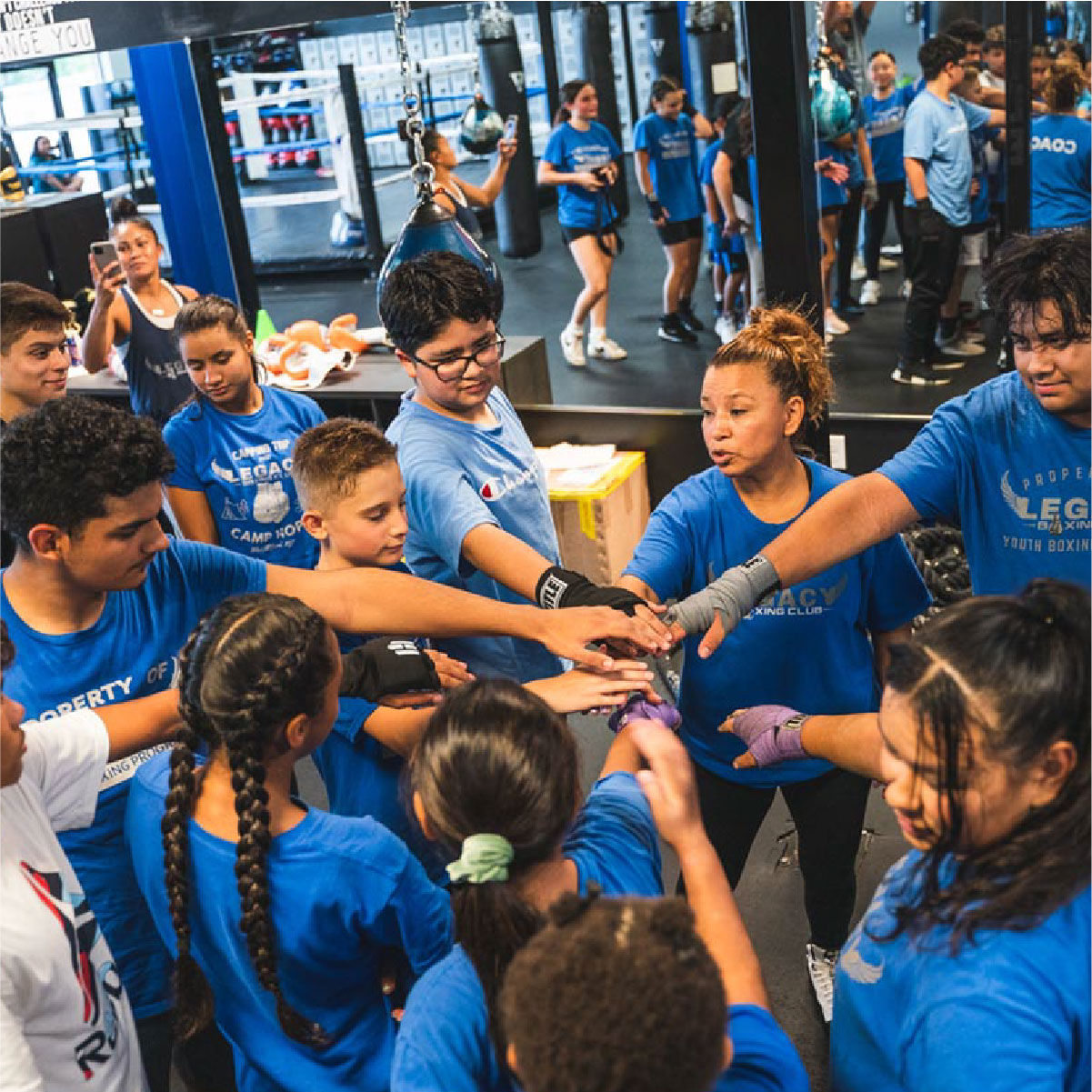
In addition to staying relevant, we’ve identified building resilience as a major focus in 2023. And to do this, event creators will need to be more creative than ever. Ticket sales are the most frequently cited sources of revenue, but given the economic headwinds ahead, it’s smart for creators to consider other revenue sources heading into 2023. This means diversifying event revenues and experimenting with new monetisation strategies.
Creative tactics could include:
View virtual experiences as a complementary channel
Digital isn’t just for when in-person events aren’t possible – hybrid events have many advantages and allow you to expand your reach and attract attendees from around the world.
And, if the events you run lend themselves to online-only, consider adding those to the mix to increase the frequency of your events and maintain a steady stream of revenue throughout the year. We’ve put together a helpful guide to hosting a virtual event so you can get started.
Consider different ticket types
There’s no average attendee, so why should your ticket type be one-size-fits-all? When asked to select their top-three revenue sources, only 10% and 8% of event creators in the UK and Ireland respectively cited premium experiences, despite VIP tickets being a potentially robust source of added revenue. In addition, the two most popular sources of event revenue are online advance ticket purchases (50% in UK, 47% in Ireland) and in-person day-of-event ticket purchases (36% in UK, 36% in Ireland). Consider how you could boost your budget by offering early bird discounts and other incentives to encourage more attendees to purchase tickets in advance.
Expand secondary revenue sources
Merchandise and concessions are often overlooked – less than one in five event creators in the UK and Ireland cite them as a source of revenue. But these add-ons can significantly boost event income. Similarly, around one in four event creators take advantage of grants or donations (23% UK, 29% Ireland), sponsorship (23% UK, 26% Ireland) and partnerships (24% UK, though just 18% of event creators in Ireland said partnerships are a source of revenue). And while crowdfunding could provide a much-needed cash injection – as well as attracting potential attendees – just 9% of event creators in Ireland and 15% in the UK have explored this avenue.
Consider new ways to sell and non-traditional ways to monetise events
This could include bundling merchandise with tickets or promoting merchandise through contests and challenges, as well as subscriptions (for example, one fee that gives an attendee access to several events throughout the year), live-streams or pay-per-view content.

Overall, an eagerness for events, balanced with concerns over the economy, was the prevailing theme everywhere we conducted our survey. Attendees expressed high levels of enthusiasm for in-person gatherings, and creators expect attendee numbers to grow.
We also recorded a clear appetite for virtual events in some regions, with a significant number of attendees in the US (29%) and Australia (32%) revealing they expect to attend more virtual events in 2023 compared to 2022. With just 17% of attendees in the UK and 16% in Ireland responding positively to the same question, creators should look at what they can do to increase enthusiasm for this vital revenue stream.
But while 2023 might see attendee numbers grow, rising costs and fear of a potential recession are impacting customer decision-making. Just like the UK (81%) and Ireland (85%), nearly 80% of US attendees said inflation is causing audiences to tighten their budgets.
Creators around the world also cited financial concerns. The top-ranked challenge listed in Australia (32%), New Zealand (37%), America (29%) and Canada (32%) was ‘insufficient budget’. But despite UK respondents bracing for worsening economic conditions (+18 percentage points higher than the global average), their top challenge was ‘reaching attendees’ – which was cited by 32% of UK creators.
 What’s going on? Our questions around competition within the events space can help explain this different outlook because, though one in three creators globally strongly agreed that there are more competitors in their event space compared to a year ago, competition is fiercest in the UK (39%) and Ireland (37%). (That said, we should acknowledge that reaching attendees was far less of an issue in Ireland, with just 18% of creators citing this challenge.)
What’s going on? Our questions around competition within the events space can help explain this different outlook because, though one in three creators globally strongly agreed that there are more competitors in their event space compared to a year ago, competition is fiercest in the UK (39%) and Ireland (37%). (That said, we should acknowledge that reaching attendees was far less of an issue in Ireland, with just 18% of creators citing this challenge.)
So while there’s no denying that finding ways to make your mark will be something UK creators will be grappling with in 2023, we hope they can take comfort in the fact that all this competition is surely proof that the industry is alive and well!
It also points to the UK and Ireland’s mature events landscape. Just as in the US and Canada, creators here strongly identify as experience designers, while that number is lower in Australia and New Zealand. In addition, UK and Ireland attendees expressed the greatest appetite for experiences – more than 60% would choose to attend an event over receiving physical gifts compared to the US (56%) and Australia (59%). Our advice is to really tap into the importance attendees place on events – especially the 31% in Ireland who said that spending on live events and/or experiences is an essential or high priority – the highest in any region we surveyed.
What we know for sure from our 2023 Event Trends Report is that attendees have an appetite for events like never before, and now’s the time to think about how you can make the next 12 months even more memorable than the last. You might decide to add an extra event to your schedule or experiment with hybrid and digital formats. Or maybe you’re ready to try a new marketing channel, seek out alternative revenue sources, or explore new ticket-pricing strategies.
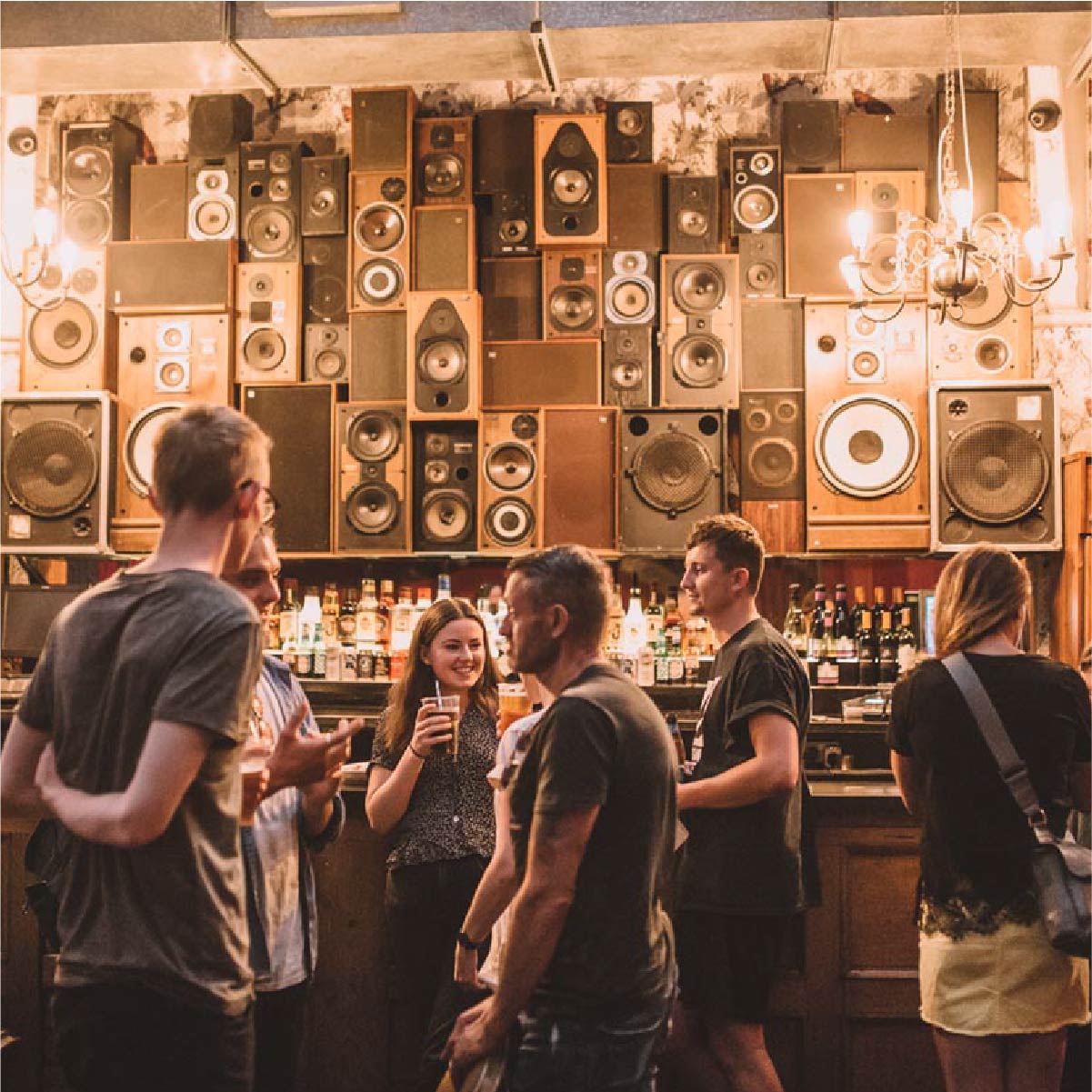
Whoever you run your events for – from the introverts looking to party locally with those they know, to the extroverts who want to expand their social circles through live experiences – now’s the time to really tune into audience expectations and tailor your events for them. And while there’s no denying the challenges that lie ahead, our survey shows creators around the world have the drive to turn adversity into opportunity.
Feeling inspired and ready to host your next event? We’d love to help. Contact our events team.